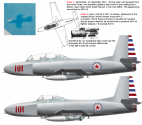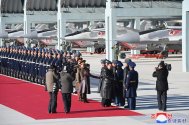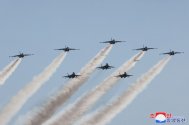blue, olive green, sandy yellow, or any other color anyone can use to paint, doesn't change the meaning of my answer you quoted..CHECK color, its blue. I've never seen that color ammo before, it looks like North Korean stock rather than foreign trade product.
You are using an out of date browser. It may not display this or other websites correctly.
You should upgrade or use an alternative browser.
You should upgrade or use an alternative browser.
North Korea Military News, Reports, Data, etc.
- Thread starter FORBIN
- Start date
-
- Tags
- north korea
I think those are L-29 Delfin or L-39 Albatross.At the end of Kim Jong Un's visit to the aviation plants where fighter jets and commercial aircraft are produced, Deputy Prime Minister and Minister of Industry and Trade of the Russian Federation Denis Manturov said:
“We demonstrated to the leader of the Democratic People's Republic of Korea one of our main aircraft production facilities. We see the potential for cooperation both in the field of aircraft production and in other areas this is especially relevant for achieving the tasks that our countries must face in achieving technological "technological sovereignty"
These words lead me to be even more convinced that in the medium term a combat aircraft made in DPRK will appear on the peninsula.
And this satellite photo from a few months ago comes to mind
View attachment 118837
Not Su-25.
Yes, even possible, at least those with straight wings.I think those are L-29 Delfin or L-39 Albatross.
Not Su-25.
L-29

L-39

the only problem is that there are currently no photos or news of the presence of these 2 trainer models in the ranks of the DPRK.
It is certainly always possible that in the post-Soviet years and with the independence of many states that were part of it, they may have purchased L-29s and L-39s resulting in surplus, as actually done with the Mig-21Bis.
Alternatively, if we are talking about trainers, the possibility that it is an attempt to create a national training aircraft, which in truth, for a young aeronautical industry would be the simplest way to start.. As China did when it built the first domestic jet-engine aircraft, the JJ-1 trainer (at the time the turbojet engine used was that of the Mig-15, a very well-known engine and also used today in DPRK)

But like all other hypotheses until there are images or official news, it remains only a personal thought.
Again personal hypotheses and playing with images, a few years ago I had developed a fantasy drawing of how the North Korean Trainer + a single-seater COIN version could appear.
Made by interpreting some news from the past
1) the attempt to create a combat aircraft derived from the MiG-15,
2) subsequent news regarding the ability to produce in DPRK a turbojet engine Tumansky RD-9
3) observing the silhouette of a low quality image of a flying object that was indicated as immortalized in DPRK.

Made by interpreting some news from the past
1) the attempt to create a combat aircraft derived from the MiG-15,
2) subsequent news regarding the ability to produce in DPRK a turbojet engine Tumansky RD-9
3) observing the silhouette of a low quality image of a flying object that was indicated as immortalized in DPRK.

If for domestic trainer jet and counter insurgency aircraft they were to use RD-9 based turbojet then size and weight of it would possibly be comparable to L-159 Alca yet production of new engines along spare parts for RD-9 may not be available for such kind of aircraft.
For example if Su-25 were modified to use RD-9 instead of R-195 either due to resources of those were used up or to simplify logistics since parts for R-195 are compatible with R-13 turbojet engines for older MiG-21's thus might be allocated to maintain flight worthy jet fleet.
Though we need to consider implications of miniature turbofan that are used for land, ship and submarine launched cruise missiles as for example Hwasal-2 has nearly 3 hour flight time with range of 2000 kilometers hence at very least those engines can work for that long yet there is unknown if that is limitation of operational time or design of missile used on such as fuel capacity along not being too heavy for it.
In any case production of what is apparent to be TRDD-50/36MT based miniature turbofan is indication of industrial capacity of DPRK to manufacture such rather complex engine at such small size while many larger countries continue to use simple turbojets on cruise missiles.
If someday evidence of L-39 being present in North Korea then we can consider that AL-25 turbofan engine could have been reverse engineered and produced by DPRK as a possibility until there some sort of evidence to confirm it after if L-39 is indeed in North Korea.
For example if Su-25 were modified to use RD-9 instead of R-195 either due to resources of those were used up or to simplify logistics since parts for R-195 are compatible with R-13 turbojet engines for older MiG-21's thus might be allocated to maintain flight worthy jet fleet.
Though we need to consider implications of miniature turbofan that are used for land, ship and submarine launched cruise missiles as for example Hwasal-2 has nearly 3 hour flight time with range of 2000 kilometers hence at very least those engines can work for that long yet there is unknown if that is limitation of operational time or design of missile used on such as fuel capacity along not being too heavy for it.
In any case production of what is apparent to be TRDD-50/36MT based miniature turbofan is indication of industrial capacity of DPRK to manufacture such rather complex engine at such small size while many larger countries continue to use simple turbojets on cruise missiles.
If someday evidence of L-39 being present in North Korea then we can consider that AL-25 turbofan engine could have been reverse engineered and produced by DPRK as a possibility until there some sort of evidence to confirm it after if L-39 is indeed in North Korea.
Supposedly Ukraine transferred the technology to make AL-25 turbofan engine to China so they could use it in the Hongdu JL-8. Given the history of past Ukrainian tech transfers to North Korea post Soviet collapse, like we see with their ballistic missile program, it would not be surprising if North Korea also got a tech transfer for the AL-25.If someday evidence of L-39 being present in North Korea then we can consider that AL-25 turbofan engine could have been reverse engineered and produced by DPRK as a possibility until there some sort of evidence to confirm it after if L-39 is indeed in North Korea.
Issue with assertion of tech transfer from Ukraine to North Korea is that it is not official nor with actual backing hence either espionage by stealing or bribing lower ranking government employees, engineers, officials and so forth to acquire examples along there being also a fact that Ukraine does not have ability to manufacture new RD-250 rocket engine system along older 4D10 hence regardless North Korea would have to invest into research and development of materials for use in manufacturing those thus basically reinvent it with maybe different style.Supposedly Ukraine transferred the technology to make AL-25 turbofan engine to China so they could use it in the Hongdu JL-8. Given the history of past Ukrainian tech transfers to North Korea post Soviet collapse, like we see with their ballistic missile program, it would not be surprising if North Korea also got a tech transfer for the AL-25.
Also North Korea developed further RD-250 to have gimballed/swiveled exhaust nozzles which is feature set that for example RD-170 has.
Involving solid fuel ballistic missiles all those trace origin to reverse engineered OTR-21 Tochka hence some components were upscaled such as jet vanes for thrust vector control along grid fins for some of them, in the end DPRK is reinventing with some rather minor shortcuts with rest being own development or that jointly with Iran such as 360 degree swiveled nozzle for a solid fuel rocket motor as seen on Hwasong-18.
Neither China nor Russia would provide anything substantial as North Korea on arms market was competitor until sanctions regime which was in interest of both as it removed considerable competitor on arms market since North Korea provided equivalent at considerably lower price.
Only thing that China provided involving jet aircraft is maintenance facility and perhaps technology transfer to produce their close of RD-9 turbojet engine with that being in late 1970s or early 1980s thus any development there after since collapse of communist bloc and China converting to capitalist system economically effectively ceased any transfer of technology due to various reasons, political and economic.
Only partner that North Korea can rely on with technology transfer, both ways is with Iran as they do have joint development and research.
That's disingenuous. Ukraine had their own capability to design and manufacture rocket engines if necessary. One good example of this is how they developed the hypergolic RD-843 engine used as the last stage in Vega. Or the staged combustion gimballed upper stage RD-8 engine for the Zenit.Issue with assertion of tech transfer from Ukraine to North Korea is that it is not official nor with actual backing hence either espionage by stealing or bribing lower ranking government employees, engineers, officials and so forth to acquire examples along there being also a fact that Ukraine does not have ability to manufacture new RD-250 rocket engine system along older 4D10 hence regardless North Korea would have to invest into research and development of materials for use in manufacturing those thus basically reinvent it with maybe different style.
The RD-250 rocket engine was designed in Soviet Russia. But the production of the engine and the test facilities were in Soviet Ukraine in Dnepropetrovsk. Production of the RD-250 there ended in 1991. The production line was dismantled three years afterwards. So it is perfectly obvious they could have easily transferred the production facilities.
Last edited:
You say that is disingenuous only to prove my point as neither RD-843 nor RD-8 are in same category as RD-250 by any metric.That's disingenuous. Ukraine had their own capability to design and manufacture rocket engines if necessary. One good example of this is how they developed the hypergolic RD-843 engine used as the last stage in Vega. Or the staged combustion gimballed upper stage RD-8 engine for the Zenit.
Irrelevant, has nothing to do with North Korea.The RD-250 rocket engine was designed in Soviet Russia. But the production of the engine and the test facilities were in Soviet Ukraine in Dnepropetrovsk. Production of the RD-250 there ended in 1991. The production line was dismantled three years afterwards. So it is perfectly obvious they could have easily transferred the production facilities.





